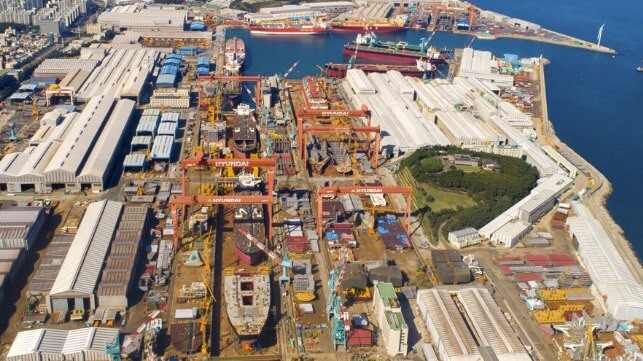South Korea’s Shipbuilders Report Solid Start to 2023

The Korean shipbuilding industry is reporting a positive start to 2023 despite the overall slowing worldwide in the pace for new orders. While China regained its lead in new orders in March, the Korean industry is emphasizing its overall leadership in the first quarter putting it on a solid path for the year as it focuses on higher-margin vessels.
The strength of newbuilding orders permitted the major Korean shipyards to exceed their targets for orders in 2022 with the industry terming the pace of orders so far in 2023 as stable. Business Korea reported last week that the three major shipbuilders, Korea Shipbuilding & Offshore Engineering, the parent of Hyundai’s shipbuilding operations, Samsung Heavy Industries, and Daewoo Shipbuilding & Marine Engineering, collective had booked a third of the annual order targets during the first quarter of 2023.
Orders received by the three shipbuilders Business Korea calculates totaled $10.5 billion with the newspaper reporting the annual target at $32 billion. KSOE reported the largest share of the orders in the first quarter at nearly $7.3 billion, which BusinessKorea reports is over 46 percent of the company’s annual target. Samsung booked $2.5 billion in the first quarter, or more than a quarter of its target, with DMSE lagging at $800 million, or 11.5 percent of its target.
The shipbuilders were pressured in 2022 by rising material and labor costs, and a shortage of workers. The Korean yards however are continuing their leadership for the orders of LNG carriers, which are the highest priced and higher margin ships as well as their focus on developing new technologies such as automation and alternative fuel systems such as methanol and ammonia. Last week’s large order from CMA CGM to China for methanol-fueled containerships following COSCO and OOCL's order last October, however, shows that Korea's lead in orders for methanol-fueled containerships, which make up the majority of the orders for the emerging power source, is quickly slipping away.
Clarksons Research projects that LNG carriers will remain a strong segment of the newbuilding market, even after a record number of orders in 2022. They are forecasting an additional 70 orders this year for LNG carriers and an annual average of 60 orders a year going forward. The strong demand has also seen the price of LNG carriers rise by a third in the past two years, topping $250 million for the current newbuild orders.
Shipbuilding orders overall however were down by approximately half in March versus the prior year based on the compensated gross tonnage calculation reported by Clarksons Research. Their March report shows total orders of 2.44 million CGT equivalent to 579 ships. Korea, which had led in the first months of 2023, slipped to second with a third of the orders in March while China retook the lead with nearly 40 percent of CGT. In February, driven by strong LNG carrier orders, Korea won three-quarters of the CGT orders.
The slowing pace of orders means that the global backlog declined slightly to just over 110 million CGT but Korean shipyards saw a slight increase in their backlog. China, however, lost one percent of its backlog as delivers outstripped orders.

that matters most
Get the latest maritime news delivered to your inbox daily.
The South Korean shipyards are looking near-term at expanding capacity as well as attracting more foreign workers to address labor shortages. By the end of last year, the three major shipyard companies each were employing more than 500 foreign workers with the South Korean government taking steps to increase the number of visas available and ease the rules governing the employment of foreigners in roles such as painters and welders. Korea’s Pulse News reports the major shipyards plan to hire an additional 3,100 foreign workers by the end of this year. They are attracting people from traditional sources such as Indonesia and Thailand as well as Vietnam and as far away as Uzbekistan.
The South Korean government continues to take steps to support the industry as it is a key contributor to the industrial economy. Last year, the government promised to aid with new recruiting and training programs to support the shipbuilders.
